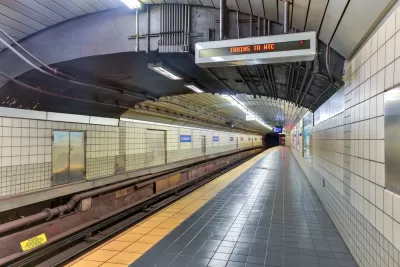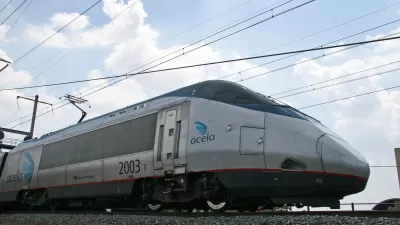After facing a series of setbacks, the plan to rehabilitate and expand train tunnels under the Hudson River is moving forward thanks to new federal support.

The tunnel linking New Jersey and New York by train under the Hudson River, first built more than a century ago, will undergo a $16 billion repair and expansion project starting in 2024 after the Gateway Development Commission took control of the project in September. As Dan Zukowski explains in Smart Cities Dive, “Legislation enacted separately by New York and New Jersey created the GDC in 2019. The commissioners include representatives of both states and Amtrak, which owns the tunnel and the rail line.”
Zukowski describes the project’s decade-plus history, noting that, despite a series of past delays, “With a more Amtrak-friendly Biden White House and money from the bipartisan infrastructure law, the tunnel project looks to be moving ahead.”
“Plans to add capacity with an additional tunnel go back to at least 2009, when work began on a project killed a year later by then-New Jersey Gov. Chris Christie. But Superstorm Sandy in 2012 flooded the tunnels with saltwater, damaging electrical and mechanical equipment and creating cracks in the concrete walls.”
The project could be completed in 2035. “After completing the new tunnel, the GDC will spend three years rehabilitating the existing tunnels, ultimately doubling track capacity to reduce delays and increase service.”
FULL STORY: $16B Hudson tunnel project for Amtrak set to begin construction in late 2024

Trump Administration Could Effectively End Housing Voucher Program
Federal officials are eyeing major cuts to the Section 8 program that helps millions of low-income households pay rent.

Planetizen Federal Action Tracker
A weekly monitor of how Trump’s orders and actions are impacting planners and planning in America.

Ken Jennings Launches Transit Web Series
The Jeopardy champ wants you to ride public transit.

California Invests Additional $5M in Electric School Buses
The state wants to electrify all of its school bus fleets by 2035.

Austin Launches $2M Homelessness Prevention Fund
A new grant program from the city’s Homeless Strategy Office will fund rental assistance and supportive services.

Alabama School Forestry Initiative Brings Trees to Schoolyards
Trees can improve physical and mental health for students and commnity members.
Urban Design for Planners 1: Software Tools
This six-course series explores essential urban design concepts using open source software and equips planners with the tools they need to participate fully in the urban design process.
Planning for Universal Design
Learn the tools for implementing Universal Design in planning regulations.
Ada County Highway District
Clanton & Associates, Inc.
Jessamine County Fiscal Court
Institute for Housing and Urban Development Studies (IHS)
City of Grandview
Harvard GSD Executive Education
Toledo-Lucas County Plan Commissions
Salt Lake City
NYU Wagner Graduate School of Public Service





























